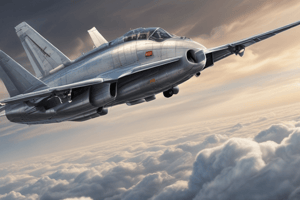Podcast
Questions and Answers
What is the primary purpose of understanding and computing load factors in aircraft performance?
What is the primary purpose of understanding and computing load factors in aircraft performance?
- To reduce the weight of the aircraft
- To ensure the safety and efficiency of the aircraft's performance (correct)
- To enhance the aesthetics of the aircraft
- To improve the pilot's comfort
What is the unit of measurement for load factors?
What is the unit of measurement for load factors?
- Dimensionless number (correct)
- Feet per second
- Kilograms per meter
- Pounds per square inch
What is the primary source of information for computing load factors in a specific aircraft?
What is the primary source of information for computing load factors in a specific aircraft?
- Aircraft Flight Manual/Pilot's Operating Handbook (correct)
- Aviation textbooks
- Pilot's personal experience
- Internet forums
What is the load factor in straight and level unaccelerated flight?
What is the load factor in straight and level unaccelerated flight?
How does the load factor change during a level turn?
How does the load factor change during a level turn?
What is the effect of a higher load factor on the aircraft and its contents?
What is the effect of a higher load factor on the aircraft and its contents?
What is the formula for calculating the load factor in a level turn?
What is the formula for calculating the load factor in a level turn?
Why must the lift increase during maneuvers such as turns and climbs?
Why must the lift increase during maneuvers such as turns and climbs?
What is the term commonly used to refer to the load factor?
What is the term commonly used to refer to the load factor?
What is the primary benefit of understanding load factors in aircraft performance?
What is the primary benefit of understanding load factors in aircraft performance?
The load factor is the ratio of the aircraft's weight to the total lift.
The load factor is the ratio of the aircraft's weight to the total lift.
A load factor of 2 G's means the aircraft is experiencing twice its weight in stress.
A load factor of 2 G's means the aircraft is experiencing twice its weight in stress.
The load factor is only critical during takeoff and landing.
The load factor is only critical during takeoff and landing.
The Aircraft Flight Manual/Pilot's Operating Handbook (AFM/POH) contains information on aircraft maintenance schedules.
The Aircraft Flight Manual/Pilot's Operating Handbook (AFM/POH) contains information on aircraft maintenance schedules.
The load factor can be calculated using the formula n = Weight / Lift.
The load factor can be calculated using the formula n = Weight / Lift.
A higher load factor always results in a decrease in the aircraft's airspeed.
A higher load factor always results in a decrease in the aircraft's airspeed.
The load factor is only important during vertical maneuvers such as climbs and dives.
The load factor is only important during vertical maneuvers such as climbs and dives.
The bank angle of the aircraft has no effect on the load factor during a level turn.
The bank angle of the aircraft has no effect on the load factor during a level turn.
The load factor is a dimensionless quantity.
The load factor is a dimensionless quantity.
The load factor is only relevant for military aircraft.
The load factor is only relevant for military aircraft.
What is the significance of the load factor in relation to the safety and efficiency of an aircraft's performance?
What is the significance of the load factor in relation to the safety and efficiency of an aircraft's performance?
How does the load factor change during a climb or dive, and why is this change necessary?
How does the load factor change during a climb or dive, and why is this change necessary?
What is the relationship between the bank angle and load factor during a level turn, and how does this affect the aircraft's performance?
What is the relationship between the bank angle and load factor during a level turn, and how does this affect the aircraft's performance?
Why is it essential to consult the Aircraft Flight Manual/Pilot's Operating Handbook (AFM/POH) when computing load factors for a specific aircraft?
Why is it essential to consult the Aircraft Flight Manual/Pilot's Operating Handbook (AFM/POH) when computing load factors for a specific aircraft?
How does a higher load factor affect the aircraft's structure and its contents, and what are the implications for safe flight?
How does a higher load factor affect the aircraft's structure and its contents, and what are the implications for safe flight?
What is the significance of the load factor being a dimensionless quantity, and how does this affect its application in aircraft performance calculations?
What is the significance of the load factor being a dimensionless quantity, and how does this affect its application in aircraft performance calculations?
How does the load factor relate to the concept of 'G-force,' and what are the implications for aircraft performance and safety?
How does the load factor relate to the concept of 'G-force,' and what are the implications for aircraft performance and safety?
What are the consequences of exceeding the load factor limits specified in the Aircraft Flight Manual/Pilot's Operating Handbook (AFM/POH)?
What are the consequences of exceeding the load factor limits specified in the Aircraft Flight Manual/Pilot's Operating Handbook (AFM/POH)?
How does the load factor affect the aircraft's airspeed during maneuvers, and what are the implications for aircraft performance?
How does the load factor affect the aircraft's airspeed during maneuvers, and what are the implications for aircraft performance?
What role does the load factor play in the overall understanding of an aircraft's performance, and why is it critical for pilots to comprehend this concept?
What role does the load factor play in the overall understanding of an aircraft's performance, and why is it critical for pilots to comprehend this concept?
Flashcards are hidden until you start studying
Study Notes
Aircraft Performance Metrics
- Key performance metrics are essential for making informed decisions in varying circumstances and are not just numbers to memorize.
- These metrics serve a unique purpose and are crucial for pilots to understand to ensure safe and efficient flight operations.
Takeoff and Landing Distances
- Takeoff and landing distances are critical metrics that inform pilots about the runway lengths required for safe operations.
- These distances vary depending on weight configurations and environmental conditions.
Rate of Climb
- The rate of climb is an indicator of how quickly an aircraft ascends.
- Pilots must understand this figure to ensure safe separation from terrain and obstacles, especially during the initial phases of flight.
Cruise Speed
- Cruise speed represents the optimal velocity for an aircraft during the longest phase of flight.
- It balances time efficiency with fuel consumption.
Fuel Consumption
- Understanding an aircraft's fuel consumption is pivotal for flight planning and avoiding unwelcome surprises aloft.
Stall Speed
- Stall speed is the minimum airspeed at which an aircraft can fly while maintaining control.
- Knowing an aircraft's stall speeds is fundamental for safe maneuvering, particularly during takeoffs and landings.
Weight and Balance
- Weight and balance heavily influence an aircraft's performance.
- Recognizing how to calculate and maintain an aircraft's weight and balance is vital for optimal performance.
Importance of Performance Metrics
- Performance metrics are dynamic values that change with conditions and are integral to adapting flight operations.
- Monitoring these metrics is not a set-and-forget task; it's a constant practice throughout a pilot's journey.
Determining Stall Speeds
- Stall speed is the speed at which an aircraft's wings cannot produce enough lift to sustain flight due to an excessive angle of attack.
- Knowing an aircraft's stall speeds for different configurations and weights is crucial for safe operation throughout all phases of flight.
Aircraft Flight Manual (AFM) and Pilot's Operating Handbook (POH)
- The AFM and POH are the bible for pilots when it comes to knowing their aircraft.
- These documents contain a wealth of information, including operating limits, procedures, performance data, and stall speeds.
Calculating Stall Speeds
- Stall speed calculations involve considering factors such as flap configuration, aircraft loading, and center of gravity.
- The step-by-step calculation involves adjusting the basic stall speed in the clean configuration for the current weight and other factors.
Load Factors
- Load factors, often referred to as 'G-force,' indicate the amount of stress placed on an aircraft's structure during maneuvers.
- The load factor is the ratio of the total lift to the aircraft's weight and is expressed as a dimensionless number.
Computing Load Factors
- The simplest formula for computing the load factor (n) in straight and level unaccelerated flight is: n = Lift / Weight
- During maneuvers such as turns, climbs, and dives, the lift must increase to counteract the additional forces, thus increasing the load factor.
Aircraft Performance Metrics
- Key performance metrics are essential for making informed decisions in varying circumstances and are not just numbers to memorize.
- These metrics serve a unique purpose and are crucial for pilots to understand to ensure safe and efficient flight operations.
Takeoff and Landing Distances
- Takeoff and landing distances are critical metrics that inform pilots about the runway lengths required for safe operations.
- These distances vary depending on weight configurations and environmental conditions.
Rate of Climb
- The rate of climb is an indicator of how quickly an aircraft ascends.
- Pilots must understand this figure to ensure safe separation from terrain and obstacles, especially during the initial phases of flight.
Cruise Speed
- Cruise speed represents the optimal velocity for an aircraft during the longest phase of flight.
- It balances time efficiency with fuel consumption.
Fuel Consumption
- Understanding an aircraft's fuel consumption is pivotal for flight planning and avoiding unwelcome surprises aloft.
Stall Speed
- Stall speed is the minimum airspeed at which an aircraft can fly while maintaining control.
- Knowing an aircraft's stall speeds is fundamental for safe maneuvering, particularly during takeoffs and landings.
Weight and Balance
- Weight and balance heavily influence an aircraft's performance.
- Recognizing how to calculate and maintain an aircraft's weight and balance is vital for optimal performance.
Importance of Performance Metrics
- Performance metrics are dynamic values that change with conditions and are integral to adapting flight operations.
- Monitoring these metrics is not a set-and-forget task; it's a constant practice throughout a pilot's journey.
Determining Stall Speeds
- Stall speed is the speed at which an aircraft's wings cannot produce enough lift to sustain flight due to an excessive angle of attack.
- Knowing an aircraft's stall speeds for different configurations and weights is crucial for safe operation throughout all phases of flight.
Aircraft Flight Manual (AFM) and Pilot's Operating Handbook (POH)
- The AFM and POH are the bible for pilots when it comes to knowing their aircraft.
- These documents contain a wealth of information, including operating limits, procedures, performance data, and stall speeds.
Calculating Stall Speeds
- Stall speed calculations involve considering factors such as flap configuration, aircraft loading, and center of gravity.
- The step-by-step calculation involves adjusting the basic stall speed in the clean configuration for the current weight and other factors.
Load Factors
- Load factors, often referred to as 'G-force,' indicate the amount of stress placed on an aircraft's structure during maneuvers.
- The load factor is the ratio of the total lift to the aircraft's weight and is expressed as a dimensionless number.
Computing Load Factors
- The simplest formula for computing the load factor (n) in straight and level unaccelerated flight is: n = Lift / Weight
- During maneuvers such as turns, climbs, and dives, the lift must increase to counteract the additional forces, thus increasing the load factor.
Aircraft Performance Metrics
- Key performance metrics are essential for making informed decisions in varying circumstances and are not just numbers to memorize.
- These metrics serve a unique purpose and are crucial for pilots to understand to ensure safe and efficient flight operations.
Takeoff and Landing Distances
- Takeoff and landing distances are critical metrics that inform pilots about the runway lengths required for safe operations.
- These distances vary depending on weight configurations and environmental conditions.
Rate of Climb
- The rate of climb is an indicator of how quickly an aircraft ascends.
- Pilots must understand this figure to ensure safe separation from terrain and obstacles, especially during the initial phases of flight.
Cruise Speed
- Cruise speed represents the optimal velocity for an aircraft during the longest phase of flight.
- It balances time efficiency with fuel consumption.
Fuel Consumption
- Understanding an aircraft's fuel consumption is pivotal for flight planning and avoiding unwelcome surprises aloft.
Stall Speed
- Stall speed is the minimum airspeed at which an aircraft can fly while maintaining control.
- Knowing an aircraft's stall speeds is fundamental for safe maneuvering, particularly during takeoffs and landings.
Weight and Balance
- Weight and balance heavily influence an aircraft's performance.
- Recognizing how to calculate and maintain an aircraft's weight and balance is vital for optimal performance.
Importance of Performance Metrics
- Performance metrics are dynamic values that change with conditions and are integral to adapting flight operations.
- Monitoring these metrics is not a set-and-forget task; it's a constant practice throughout a pilot's journey.
Determining Stall Speeds
- Stall speed is the speed at which an aircraft's wings cannot produce enough lift to sustain flight due to an excessive angle of attack.
- Knowing an aircraft's stall speeds for different configurations and weights is crucial for safe operation throughout all phases of flight.
Aircraft Flight Manual (AFM) and Pilot's Operating Handbook (POH)
- The AFM and POH are the bible for pilots when it comes to knowing their aircraft.
- These documents contain a wealth of information, including operating limits, procedures, performance data, and stall speeds.
Calculating Stall Speeds
- Stall speed calculations involve considering factors such as flap configuration, aircraft loading, and center of gravity.
- The step-by-step calculation involves adjusting the basic stall speed in the clean configuration for the current weight and other factors.
Load Factors
- Load factors, often referred to as 'G-force,' indicate the amount of stress placed on an aircraft's structure during maneuvers.
- The load factor is the ratio of the total lift to the aircraft's weight and is expressed as a dimensionless number.
Computing Load Factors
- The simplest formula for computing the load factor (n) in straight and level unaccelerated flight is: n = Lift / Weight
- During maneuvers such as turns, climbs, and dives, the lift must increase to counteract the additional forces, thus increasing the load factor.
Studying That Suits You
Use AI to generate personalized quizzes and flashcards to suit your learning preferences.




